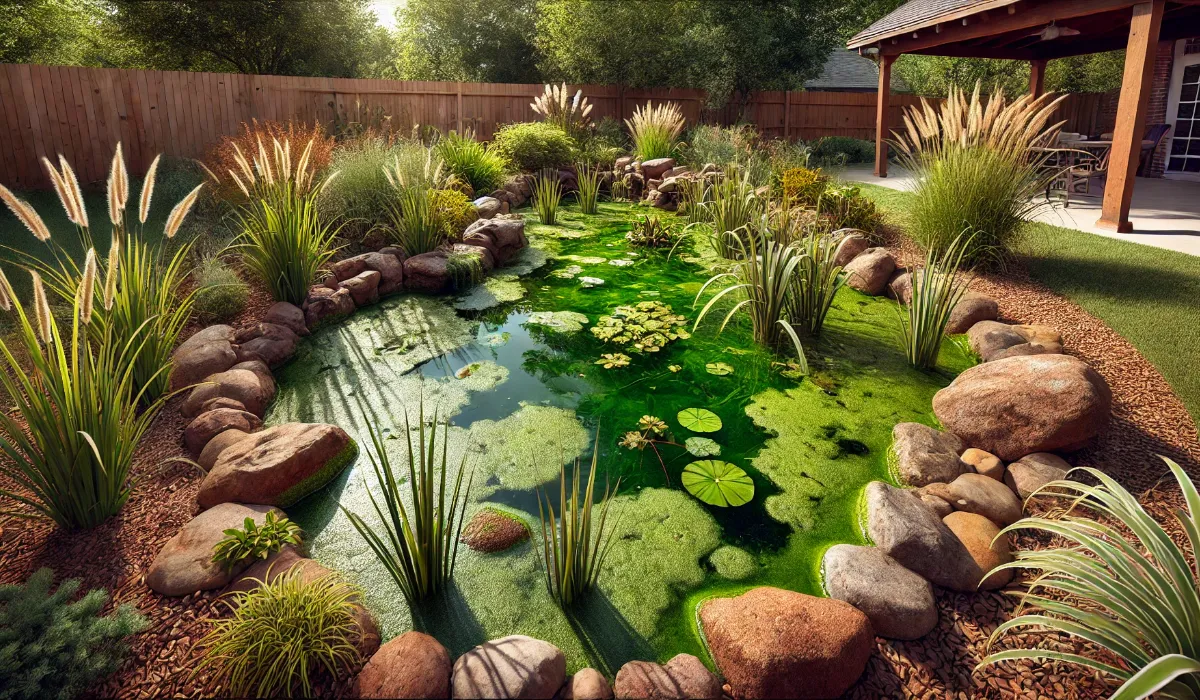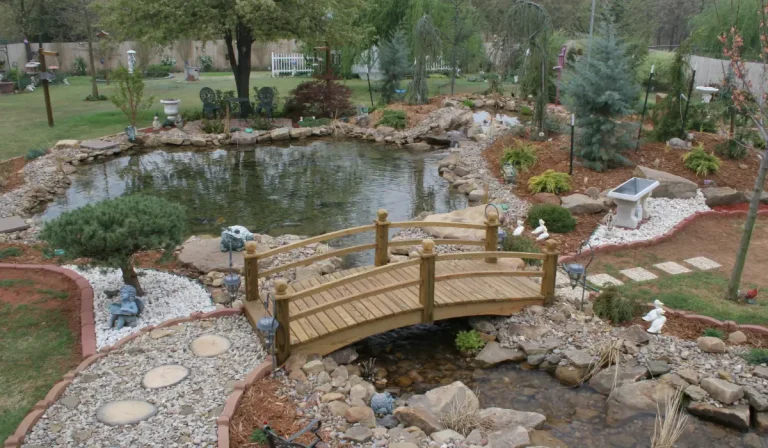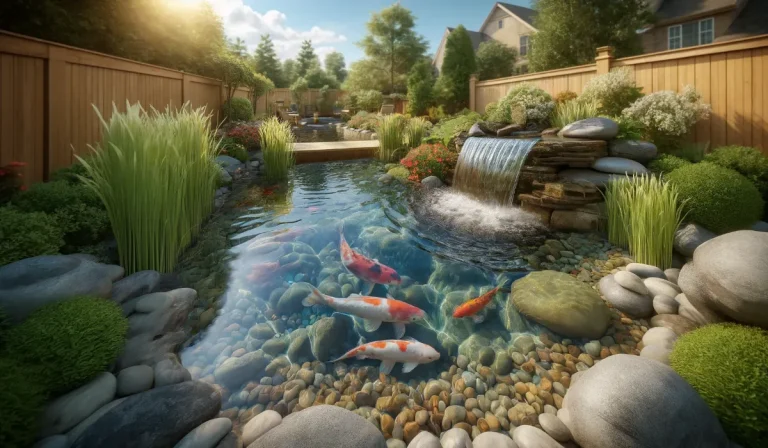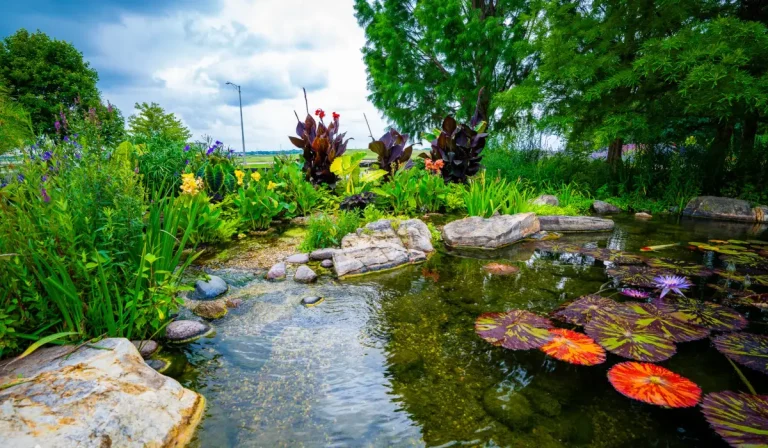How To Control Algae In Your Pond
Algae is a common concern for pond owners, whether you’ve been maintaining a water feature for years or have just purchased a home with a pond. While some algae are normal and even beneficial, overgrowth can quickly turn your serene oasis into a murky, uninviting mess. Understanding why algae grow and how to control it is essential to maintaining a healthy, beautiful pond. Here’s an in-depth guide to help you tackle algae effectively.
What Is Algae, and Why Does It Grow in Ponds?
Algae are simple aquatic organisms that thrive in ponds, lakes, and other bodies of water. While they play a natural role in the ecosystem by producing oxygen and serving as food for some aquatic creatures, excessive algae can disrupt the delicate balance of a pond.
Conditions for Algae Growth:
1. Sunlight: Algae need sunlight to photosynthesize and grow. Ponds exposed to direct sunlight are more prone to algae blooms but this is very manageable with Garden Ponds Unlimited® S.A.T. and D-Solv.
2. Nutrients: Algae feed on nutrients such as nitrates and phosphates, which often come from fish waste, decaying plant matter, and fertilizers that run off into the pond.
3. Warm Water: Algae thrive in warm temperatures, making spring and summer prime seasons for rapid growth.
Types of Algae:
Green Water Algae: Microscopic algae that float in the water, causing it to turn green and cloudy.
String Algae: Long, hair-like strands that grow on surfaces such as rocks, plants, and pond walls.
Why Algae Overgrowth Is a Problem
Excessive algae can cause several issues in your pond:
-
- Reduced Water Clarity: Algae overgrowth makes the water cloudy, obscuring the beauty of your pond and fish.
- Oxygen Depletion: Algae consume oxygen at night, which can lead to low oxygen levels and stress or kill fish.
- Impact on Fish Health: Algae blooms can create toxins that harm fish and other aquatic life.
- Clogged Systems: Thick algae can clog filters, pumps, and other equipment, reducing efficiency and increasing maintenance needs.
Maintaining Water Quality
Good water quality is the foundation of algae control. When water quality is balanced, algae have fewer nutrients to feed on, making it harder for them to thrive.
1. Test Your Water: Regularly test your pond water for pH, ammonia, nitrites, and nitrates. Aim for a pH between 6.8 and 8.2, and keep ammonia and nitrite levels at zero.
2. Avoid Overfeeding Fish: Uneaten food decomposes in the pond, contributing to nutrient buildup and algae growth. Feed only what your fish can consume in a few minutes. Feeding high quality fish food found at our retail pond supply store with help. High quality food causes the fish to absorb majority of the food rather than pass it as waste.
3. Remove Debris Promptly: Decaying leaves, plants, and other organic matter release nutrients that fuel algae growth. Skim debris regularly to prevent accumulation. Have your pond or water feature cleaned semi-annually.
Using Filtration Systems to Control Algae
Filtration systems are essential for maintaining clean, algae-free water.
-
- Mechanical Filtration (Skimmer or Intake Bay): Removes debris and particles from the water, reducing the nutrients available for algae to feed on.
- Biological Filtration: Uses beneficial bacteria found in our S.A.T. to break down fish waste and convert harmful ammonia into less harmful nitrates, which plants can absorb.
- UV Clarifiers: These devices use ultraviolet light to kill free-floating algae, preventing green water without harming fish or beneficial bacteria.
Ensure your filtration system is appropriately sized for your pond’s volume and fish load. A system that is too small may struggle to keep up with algae and nutrient levels. Proper pump size is important too.
The Role of Aquatic Plants in Algae Control
Aquatic plants are one of the most effective natural methods for controlling algae. They compete with algae for sunlight and nutrients, helping to keep algae growth in check.
- Floating Plants: Plants like water lilies, water hyacinths and water lettuce block sunlight, preventing algae from photosynthesizing.
- Submerged Plants: Oxygenators like anacharis and hornwort absorb nutrients directly from the water and release oxygen, improving water quality.
- Marginal Plants: Pickerelweed, arrowhead, and iris filter excess nutrients at the pond’s edges, reducing algae’s food supply.
Incorporating a mix of these plants creates a balanced ecosystem that naturally inhibits algae growth.
Adding Fish to Help Control Algae
Certain fish species are natural algae-eaters and can help manage algae growth in your pond.
- Plecostomus: These bottom-dwelling fish feed on algae growing on rocks and pond walls.
- Koi and Goldfish: While not primary algae-eaters, these fish help control algae indirectly by stirring up sediment, which can make algae easier to filter out.
- Hi-Fin Banded Shark: Excellent algae-eaters.
When adding fish, avoid overstocking, as too many fish can lead to nutrient overload, which exacerbates algae problems.
Physically Removing Algae
Sometimes, manual removal is necessary to manage algae, especially for string algae.
-
- Tools to Use: Use brushes, or skimmers to remove string algae from rocks and pond surfaces.
- Regular Maintenance: Removing algae manually prevents it from decomposing in the pond and releasing nutrients back into the water.
Garden Ponds Unlimited® D-solv actively dissolves the algae on contact.
Preventative Measures for Algae Control
Prevention is key to keeping algae growth under control:
1. Limit Sunlight: Use floating plants and lilies to reduce sunlight exposure.
2. Add Pond Dye: Pond dyes can block sunlight penetration, slowing algae growth while maintaining water aesthetics.
3. Maintain Regular Cleaning: Schedule routine pond maintenance to prevent debris accumulation and nutrient buildup. We recommend having your pond or water feature cleaned twice a year. Ideally in the fall and late winter.
Chemical Treatments: When and How to Use Them
-
- Choose our eco-friendly algaecide “Green Away” that is safe for fish and plants.
- Follow the manufacturer’s instructions carefully to avoid overdosing, which can harm aquatic life.
- Use treatments in combination with other methods to achieve long-term algae control.
Seasonal Considerations for Algae Control
Algae growth varies with the seasons, so it’s important to adjust your pond care routine accordingly:
- Spring and Summer: These are peak algae growth seasons. Focus on adding S.A.T., D-Solv, water testing, filtration, and plant coverage.
- Fall: Remove fallen leaves and organic debris with a pond cleaning to reduce nutrient buildup over winter.
- Winter: Monitor oxygen levels and use an aerator or de-icer to maintain water movement. Have your pond cleaned again in the late winter months. February is most ideal so that it will be ready to go for spring.
Controlling algae in your pond requires a combination of strategies, from maintaining water quality and using effective filtration systems to incorporating the right aquatic plants and fish.
Regular maintenance and preventative measures can help keep algae at bay, ensuring your pond remains a healthy and beautiful centerpiece in your outdoor space.
If you need advice, supplies, or professional assistance, the experts at Garden Ponds Unlimited® are here to help. Contact us today to learn more about how we can help you maintain a clear, algae-free pond year-round!








